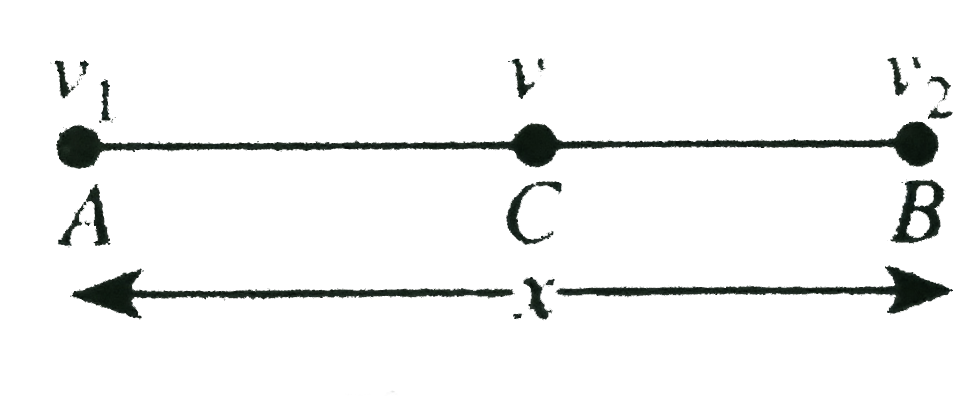A particle, moving with uniform acceleration along a straight line ABC, crosses point A at t = 0 with a velocity 12 m/s. B is 40 m from A and C is 64 m from A. The particle passes B at t = 4 s.
(a) At what time, will the particle be C?
(b) What is its velocity at C?
To solve the problem step by step, we will first analyze the motion of the particle and then calculate the required values.
Given Data:
- Initial velocity at point A (u) = 12 m/s
- Distance from A to B (s_AB) = 40 m
- Distance from A to C (s_AC) = 64 m
- Time taken to reach B (t_B) = 4 s
Step 1: Calculate the acceleration of the particle
We can use the equation of motion:
s=ut+12at2
For the distance from A to B:
- s=40m
- u=12m/s
- t=4s
Substituting these values into the equation:
40=12⋅4+12a(42)
40=48+8a
Now, rearranging to find a:
40−48=8a
−8=8a
a=−1m/s2
Step 2: Calculate the time to reach point C
We will use the equation:
V=u+at
First, we need to find the final velocity at point C using the equation:
V2=u2+2as
For the distance from A to C:
- s=64m
Substituting the values:
V2=122+2⋅(−1)⋅64
V2=144−128
V2=16
V=√16=4m/s
Now, we can find the time to reach point C using:
V=u+at
Substituting the known values:
4=12+(−1)t
4=12−t
t=12−4=8s
Final Answers:
(a) The time when the particle reaches point C is 8 seconds.
(b) The velocity at point C is 4 m/s.
- Initial velocity at point A (u) = 12 m/s
- Distance from A to B (s_AB) = 40 m
- Distance from A to C (s_AC) = 64 m
- Time taken to reach B (t_B) = 4 s
We can use the equation of motion:
s=ut+12at2
- s=40m
- u=12m/s
- t=4s
40=12⋅4+12a(42)
40=48+8a
40−48=8a
−8=8a
a=−1m/s2
We will use the equation:
V=u+at
V2=u2+2as
- s=64m
V2=122+2⋅(−1)⋅64
V2=144−128
V2=16
V=√16=4m/s
V=u+at
Substituting the known values:
4=12+(−1)t
4=12−t
t=12−4=8s
(a) The time when the particle reaches point C is 8 seconds.
(b) The velocity at point C is 4 m/s.
Topper's Solved these Questions
- MOTION IN STRAIGHT LINEBook:AAKASH INSTITUTE ENGLISHChapter:MOTION IN STRAIGHT LINEExercise:Try Yourself
Explore 40 Videos
- MOTION IN STRAIGHT LINEBook:AAKASH INSTITUTE ENGLISHChapter:MOTION IN STRAIGHT LINEExercise:Assignment (SECTION - A)
Explore 50 Videos
- MOTION IN A STRAIGHT LINEBook:AAKASH INSTITUTE ENGLISHChapter:MOTION IN A STRAIGHT LINEExercise:ASSIGNMENT (SECTION - D)
Explore 15 Videos
- MOVING CHARGE AND MAGNESIUMBook:AAKASH INSTITUTE ENGLISHChapter:MOVING CHARGE AND MAGNESIUMExercise:SECTION D
Explore 16 Videos
Similar Questions
A particle moving with uniform acceleration along a straight line ABC rosses point A at t=0 with a velocity 12ms−1.B is 40m away from A andC is 64m away from A. The particle passes B at t=4 s.a.Afterwˆtimewillthepartic≤beatC?b.WˆisitsvelocityatC?c.Wˆdoesthepartic≤reachAaga∈?d.Locatethep∮wherethepartic≤reversesitsdirectionofmotion.e.F∈dthedistancecoveredbythepartic≤∈thefirst15 s.
View SolutionA particle moving with uniform acceleration passes the point x=2m with velocity 20m/s at the instant t=0. Some time later it is observed at the point x=32m moving with velocity 10m/s.
(a) What is its acceleration?
(b) Find its position nd velocity at the instant t=8s.
(c) What is the distance traveled during the interval t=0 to 8s?
View SolutionA particle moving along a straight line with uniform acceleration has velocities 7m/s at A and 17m/s at C. B is the mid point of AC. Then :-
View SolutionA particle moving with uniform acceleration from A to B along a straight line has velcities v1 and v2 at A and B respectively. If C is the mid-point between A and B then determine the velocity of the particle at C .
 .
.
View SolutionA particle is moving with uniform acceleration along a straight line. Its velocities at A & B are respectively 7m/s & 17m/s. M is mid point of AB. If t1 is the time taken to go from A to M and t2 the time taken to go from M to B, the ratio t1t2 is equal to :-
View SolutionA particle moves with a uniform velocity of 50 m/s for 20 min. What is the velocity of particle at t = 2 min ?
View SolutionA particle starts to move in a straight line from a point with velocity 10 m s−1 and acceleration - 2.0 ms−2. Find the position and velocity of the particle at (i) t = 5 s, (ii) t' = 10 s.
View SolutionA particle moves along a straight line its velocity dipends on time as v=4t−t2. Then for first 5s:
View SolutionA particle goes from A to B in 10s with uniform acceleration. Its velocity at A and B are 5 m/s and 25 m/s. Its acceleration (in m/s2) is
View SolutionA particle is moving along a straight line with constant acceleration. At the end of tenth second its velocity becomes 20m/s and tenth second it travels a distance od 10m. Then the acceleration of the particle will be.
View Solution